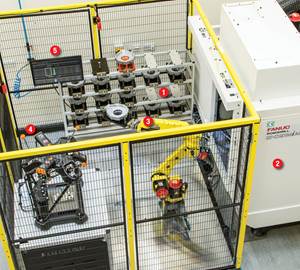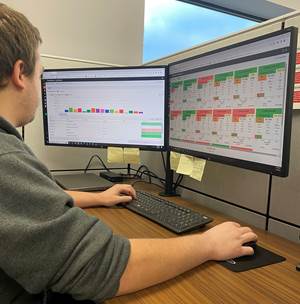Analyzing Sound Boosts Machine Monitoring
A new generation of sound analysis software detects, amplifies and records machine tool noises that can be analyzed for preventive and predictive maintenance.
Share




“I don’t like the sound of that.” That thought or expression can be an important part of being responsible for the performance of a machine tool. Sounds from the shop floor are now becoming an important part of how machines and processes can be monitored in the factory enabled by the Industrial Internet of Things (IIoT). A cutting tool that starts to chatter or make a squealing noise going into the corner of a pocket, or an unexpected clunk or tapping often indicate a less-than-optimal condition that calls for attention. A trained ear may detect even more subtle sounds that might be worrisome, such as the scraping of a ball in a ballscrew nut or spindle bearing. Recognizing that these audible clues indicate a specific response can prevent downtime or scrap.
A new generation of sound analysis software makes it possible to detect, amplify and record the noises as signals that can be digitized and acted upon. This data helps automate applications such as machine monitoring, preventive maintenance and predictive maintenance. One company, OtoSense of Palo Alto, California, is taking the next steps to use the sounds in the factory for these and other purposes based on a software platform designed to turn machine sounds into actionable meaning.
OtoSense is a Silicon Valley startup that has its roots in research originally conceived as a way to help hearing-impaired children. The value of this research for industrial applications was quickly recognized by experts eager to promote IIoT opportunities in manufacturing. OtoSense was formed in 2014 and began serving the automotive, aerospace and general manufacturing fields.
According to the developers, the software platform offered by the company is distinguished from other concepts of sound and vibration monitoring by its ability to be quickly taught which anomalous sounds to detect and identify. If an identified sound requires action, this system can alert the appropriate responder. However, the software is able to go several steps beyond this ability, says Jags Kandasamy, chief product officer at OtoSense.
The software can “listen” to ambient noise in a factory or machine shop to detect a number of significant noises at once. It is not necessary to have a sensor or microphone “tuned” to a certain sound or specific source of sounds, Mr. Kandasamy says. For example, the software can record and map each new anomaly to be diagnosed as a symptom of an actionable event, which can then be monitored for a triggered response.
A factory can use the software to create a library or repository of sound profiles to create a structured semantic system to enable historical analysis, trend and search capabilities in the cloud. In other words, Mr. Kandasamy explains, the sound profile can be used the way a keyword can be used to search a database. The user’s database of sound recordings and profiles can be quite large, requiring Big Data analytics capability, Mr. Kandasamy says. The software can also apply complex logic to the analysis of sounds so their meaning can be interpreted in its context.
To set up the sound-monitoring system, the user begins with any machine in which events (a motion, response, mechanical or electrical action) generate stationary and non-stationary sounds or vibrations. The next step is to install any relevant sensor delivering a time series in relation with acoustic waves, such as an accelerometer, piezo-electric device, pressure gage or laser. Signals from the sensor, in turn, are delivered as raw input to an OtoSense-enabled “edge device.” This edge device may consist of a tablet or any microprocessor-based device located on the network but acting independently of central computing resources.
The OtoSense Enabled Cloud application links to this edge device to download appropriate sound recognition models, thereby making it able to perform local, real-time or offline event recognition and anomaly detection. The sounds picked up by the sensors can be sorted out as normal, abnormal or needing to be checked as unexpected.
According to Mr. Kandasamy, one of the most promising capabilities of this technology is the opportunity to link the occurrence of an anomalous sound with a downstream event. “A sound coming from a production machine could be associated with a part jamming in an assembly operation, giving us an insight into a cause and effect that would otherwise be difficult to make,” he says.
Related Content
Protecting Your Automation Investments
Shops need to look at their people, processes and technology to get the most of out their automation systems.
Read More5 Stages of a Closed-Loop CNC Machining Cell
Controlling variability in a closed-loop manufacturing process requires inspection data collected before, during and immediately after machining — and a means to act on that data in real time. Here’s one system that accomplishes this.
Read MoreMachine Monitoring Boosts Aerospace Manufacturer's Utilization
Once it had a bird’s eye view of various data points across its shops, this aerospace manufacturer raised its utilization by 27% in nine months.
Read MoreGive Job Shop Digitalization a Customer Focus
Implementing the integrated digital technologies and automation that enhance the customer's experience should be a priority for job shops and contract manufacturers.
Read MoreRead Next
Setting Up the Building Blocks for a Digital Factory
Woodward Inc. spent over a year developing an API to connect machines to its digital factory. Caron Engineering’s MiConnect has cut most of this process while also granting the shop greater access to machine information.
Read MoreBuilding Out a Foundation for Student Machinists
Autodesk and Haas have teamed up to produce an introductory course for students that covers the basics of CAD, CAM and CNC while providing them with a portfolio part.
Read MoreRegistration Now Open for the Precision Machining Technology Show (PMTS) 2025
The precision machining industry’s premier event returns to Cleveland, OH, April 1-3.
Read More































